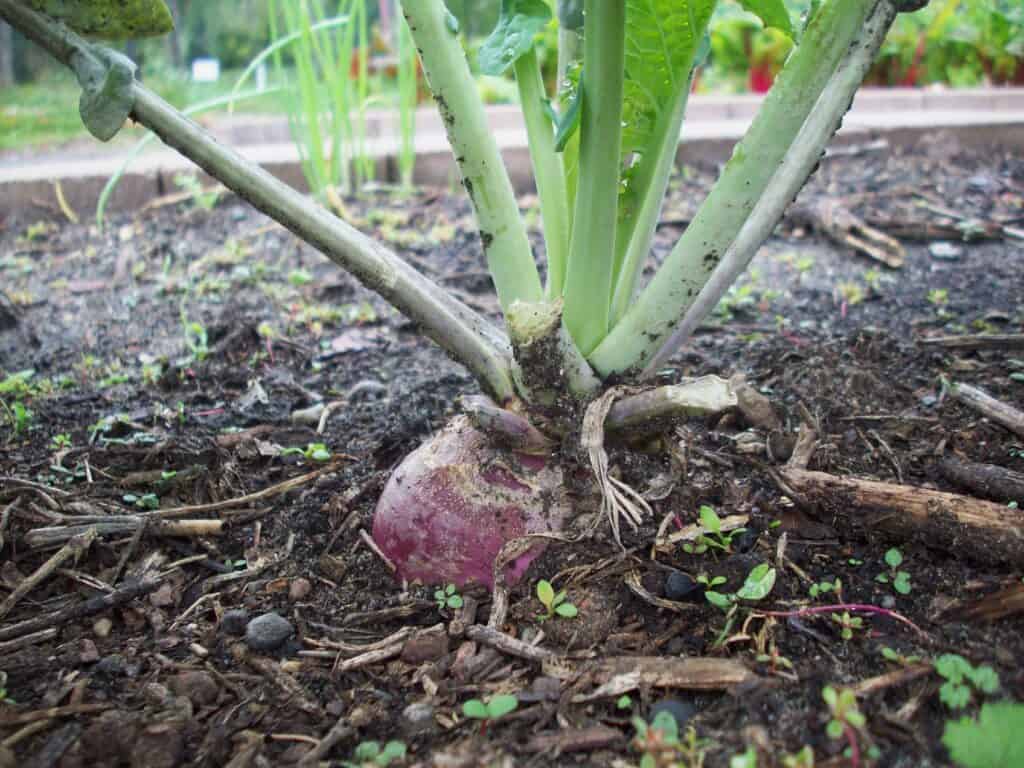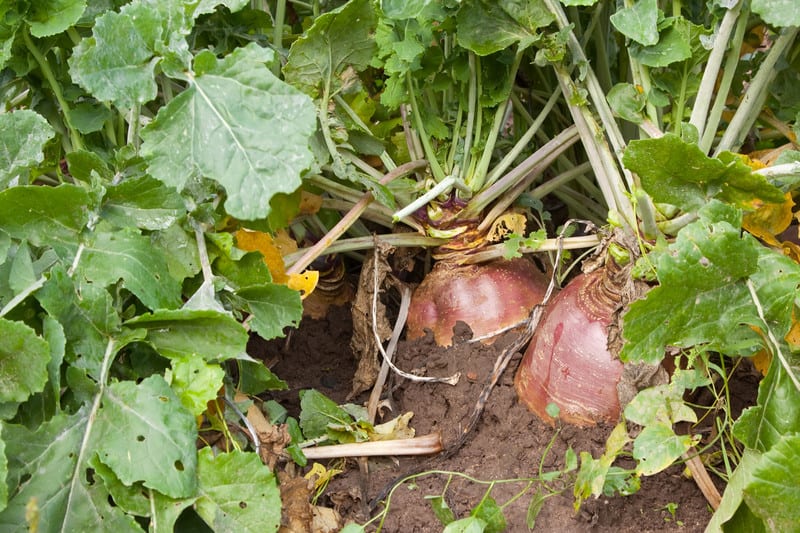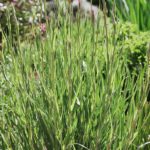Rutabaga is a cool-weather crop. Sow rutabaga seed in late winter or very early spring for an early summer harvest. Direct sow seed in the garden 16 to 10 weeks before the last frost in spring.
In warm regions, it’s best to sow rutabaga in mid-summer for a fall and winter harvest and use.
Plant rutabaga to mature in fall. Spring-planted crops grow poorly and lack the flavor of crops planted to mature in cool autumn weather.
As a general rule, plant rutabaga 15 weeks before the average date of the first fall frost where you live.
Tools for Vegetable Gardeners at Amazon:
- A.M. Leonard Straight Rake with Ash Handle
- All-Steel Nursery Spade with D-Grip Handle
- 4-Tine Spading Digging Fork with D-Handle
- Digital Soil pH Meter Outdoors Greenhouse
- Earthwise Handheld Electric Fertilizer Spreader
Rutabagas do best in medium- and short-season regions where they are planted in late spring or summer so that the roots mature in cool autumn weather. Best root development is made in temperatures averaging 60° to 65°F (16°-18°C).
When planted where summers are hot, rutabaga will produce small pithy roots.
Rutabagas that mature in warm weather will be bitter, not sweet like those that mature in cool and cold weather.
Rutabagas mature in 90 to 120 days depending on the variety.

Rutabaga planting details
- Sowing depth: ½ inch (1.2cm)
- Space between plant after thinning: 8 inches (20cm)
- Days to sprout: 7-15
- Days to harvest: 90-120
- Storage period: 12-24 weeks
- Seeds per 100-row feet: ½ ounce (14g)
- Yield per 100-row feet: 300 pounds (136kg)
- Suggested Varieties: American Purple Top, Laurentian, York
Rutabaga sowing and planting tips
Rutabaga grows best in medium-heavy soils rich in organic matter. In light soils, rutabaga must be given ample nutrients and moisture. Prepare the soil to a depth of 10 inches and work in plenty of aged compost. Mulch to keep the soil cool and moist.
Avoid excess nitrogen which will stimulate root growth at the expense of root development.
- Start rutabagas from seeds sown directly in the garden.
- Grow rutabagas and other root crops in light-textured soil free of pebbles and stones. This will ensure roots do not split or become malformed.
- The seed is viable for 4 years.
- Start seeds in the garden about 16 to 10 weeks before you expect the last frost. Rutabagas can be started indoors, but they—like most root crops—are difficult to transplant to the garden with success.
- If started indoors and transplanted, allow two additional weeks to maturity as a result of root insult at transplanting; nip off the long thread tip of the beetroot when transplanting.
- Sow seed ½ (12 mm) inch deep and be sure to heel or stamp the soil firmly in; rutabagas often fail to germinate when there is insufficient contact with the soil.
- Sow seed 2 inches apart and later thin to 4 to 6 inches (10-15 cm) apart for large storage roots.
- Space rows 12 inches (30 cm) apart.
- To improve germination sow seed at dusk or on a cool, cloudy day.
- Sow seed in loose, fertile soil. Adding aged compost to planting beds in advance of sowing will feed the soil and aid moisture retention.
- The seeds should germinate in 3 to 10 days at an optimal temperature of 70°F (21C) or thereabouts; germination will take longer in colder soil.
- The optimal soil temperature to grow rutabagas is 60°F (16°C).
- Make additional sowing at 3-week intervals for a continuous harvest, but time sowing so that the crop does not mature in hot weather.
- Rutabagas prefer a soil pH range of 6.0 to 6.5.
- Grow rutabagas in full sun for best yield; rutabagas tolerate partial shade.
- Avoid planting rutabagas where potatoes have grown recently.
- Fertilize with an organic fertilizer such as fish emulsion at half strength.
- Common pest enemies are aphids, flea beetles, and cabbage root maggots. Protect the seedlings from pests and cold for two to three weeks after planting with spun poly-row covers.
Rutabaga interplanting
- Plant rutabagas with bush beans, peas, southern peas, tomatoes, peppers, cucumbers, and squash.
- If you are planting rutabaga toward midsummer, precede the crop with Chinese cabbage, midseason carrots, early cabbages, and bush beans.
Rutabaga container growing
- To grow rutabaga in a container, choose a container 10-12 inches (25-30 cm) deep.

Rutabaga planting calendar
- 6-8 weeks before the last frost in spring: direct-sow in a plastic tunnel or cold frame.
- 4-6 weeks before the last frost in spring: direct sow in the garden; minimum soil temperature is 40°F.
Planting for fall and winter harvest
- 10-12 weeks before the first frost in fall: direct-sow in the garden.
Rutabaga planting dates for cool summer regions
(These dates are for the Northern Hemisphere)
| Average date of the last frost | Planting dates |
| Jan. 30 | Plant 15 weeks before first fall frost |
| Feb. 8 | Plant 15 weeks before first fall frost |
| Feb. 18 | Plant 15 weeks before first fall frost |
| Feb. 28 | Plant 15 weeks before first fall frost |
| Mar. 10 | Plant 15 weeks before first fall frost |
| Mar. 20 | Plant 15 weeks before first fall frost |
| Mar. 30 | Plant 15 weeks before first fall frost |
| Apr. 10 | Plant 15 weeks before first fall frost |
| Apr. 20 | Mar. 15- Apr. 15 |
| Apr. 30 | Apr. 15-May 15 |
| May 10 | May 1-June 1 |
| May 20 | May 10-20 |
| May 30 | May 20-June 1 |
| June 10 | June 1-June 10 |
Rutabaga harvest
Rutabaga will mature in 85 to 90 days. Roots can be harvested and used as soon as they are large enough to use. Plants touched by frost will have the best flavor.
Roots can be stored in the garden under a thick layer of mulch for an extended winter harvest. Do not let the roots freeze. Complete the harvest before top growth resprouts in s
Rutabaga recommended varieties
- ‘York’ has a smooth, rich flavor.
- ‘Thomson Laurentian’ stores well;.
- ‘Gilfeather’ is a sweet heirloom.
- ‘Joan’ and ‘American Purple’ has a sweet flavor.
- ‘Altaweet’ is mild flavored.
Botanical Name: Brassica napus
Rutabagas belong to the Brassicacea (Cruciferae) or cabbage family; other members include cabbage, kale, collard, broccoli, Brussels sprouts, and kohlrabi.
Rutabaga articles at Harvest to Table:
How to Plant and Grow Rutabaga
How to Harvest and Store Rutabaga
Turnip, Rutabaga, Kohlrabi Growing Problems: Troubleshooting
Garden Planning Books at Amazon:
- Vegetable Garden Grower’s Guide
- Tomato Grower’s Answer Book
- Vegetable Garden Almanac & Planner
- Kitchen Garden Grower’s Guide Vegetable Encyclopedia















